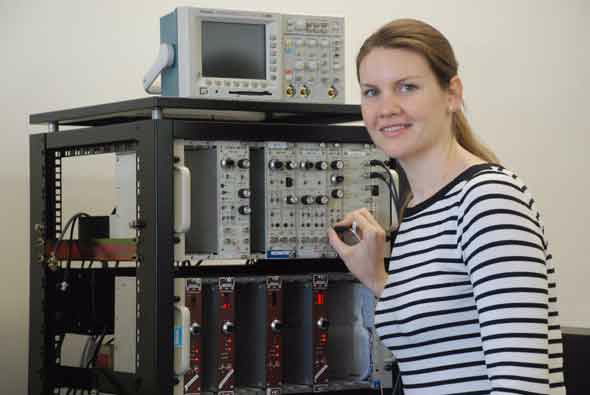ANSTO’s Radionuclide Metrology group will launch a mobile calibration service pilot project for Australian cyclotrons that produce short-lived PET radiopharmaceuticals, such as F-18 FDG (fluorodeoxyglucose).
The pilot will involve the transport of an instrument to facilities geographically distant from ANSTO to enable traceable measurements and provide calibration services.
“Australian Certified Reference Materials (ACRMs) for radionuclides such as Fluorine-18 (F-18) can’t be transported long distances because they have such short half-lives, so we need to be able to produce them onsite at the cyclotrons,” said Bonnie Howe (pictured above), a radionuclide metrologist at ANSTO.
The new initiative is an extension of ANSTO’s Australian Industry Becquerel Traceability Program (AIBTP) which has been utilised by ANSTO Health and PETNET for many years. The aim of the program is to aid radiopharmacies in the provision of correct radiopharmaceutical activities to nuclear medicine practices and assist with compliance with legislative trade measurement provisions.
The Radionuclide Metrology group also operates the Australian Nuclear Medicine Traceability Program (ANMTP), developed in consultation with the Australia and New Zealand Society of Nuclear Medicine (ANZSNM) and launched in 2014. The program operates annually and offers traceable measurements and calibration services to nuclear medicine practices, underpinning the accurate and reliable administration of radiopharmaceutical doses to patients and assisting with regulatory compliance.
The initial activities of ANMTP supported the use of the radiopharmaceuticals Technetium-99m (Tc-99m), Iodine-131 (I-131) and Gallium-67 (Ga-67). Measurement comparisons and calibrations of nuclear medicine dose calibrators were performed by ANSTO radionuclide metrologists onsite at hospitals and clinics around Australia.
“Our latest effort focuses on the production and use of the most common PET radiopharmaceutical, F-18 FDG,” said Howe.
F-18 FDG, which is widely used to diagnose neurological conditions, cancers and infectious diseases, emits gamma rays that can be detected and used to create images of metabolic processes. The radionuclide that is made in cyclotrons and linear accelerators has a half-life of only 109 minutes, the time in which half of its radioactivity will have decayed.
There were two possible approaches considered for disseminating F-18 standards.
“As you can’t send ACRMs of short-lived radionuclides long distances, you either need transfer technology or a surrogate for F-18, a similar radionuclide with a much longer half-life,” said Howe.
Previous independent research had established the suitability of Germanium-68 (Ge-68), which decays into Galium-68 (Ga-68) and has a half-life of 271 days, as a reasonable surrogate for F-18.
The Radionuclide Metrology group evaluated the suitability of the two approaches and presented the options to the Australasian Cyclotron Users Group at their meeting in Brisbane last year. The group decided that the transfer technology, a PET radionuclide ionisation chamber calibrated for F-18 against the Secondary Standard at ANSTO, was their preference.
There were some advantages to the transfer instrument over the surrogate.
“The transfer instrument is performance tested and verified for accuracy, stability of counting precision and linearity to ensure reliable results over the full range of activity,” said Howe. “We are currently investigating the possibility of distributing ACRMs from the cyclotrons to nuclear medicine practices in the local areas to enable accuracy testing of their dose calibrators as well.”
The instrument can also be calibrated for multiple radionuclides simultaneously, meaning other radionuclides can be incorporated into the program in future.
The protocol will be tested in a pilot later this year at one of Australia’s cyclotron facilities that produce PET radiopharmaceuticals.
“Measurement comparisons will be performed between the transfer instrument and the ionisation chambers at the cyclotron using F-18 FDG sources produced onsite. Initially, the measured sources will also be sent to ANSTO for direct comparison with the Secondary Standard to verify the protocol. Any ionisation chambers displaying significant deviation from the Australian standard can be re-calibrated during the service” said Howe.
If the results of the pilot are satisfactory, ANSTO will offer the program to other facilities.
“This new program is just one of the ways ANSTO’s Radionuclide Metrology group is ensuring radioactivity standards reach Australian users.
Dissemination is one of our key capabilities and an integral part of the function we perform on behalf of Australia’s Chief Metrologist”, said Dr Mark Reinhard, leader of Nuclear Stewardship at ANSTO.
Measurement accuracy is underpinned by comparison and calibration of radionuclide dose calibrators with Certified Reference Materials measured against the Australian standard for the activity of radionuclides maintained by ANSTO.
ANSTO maintains the standard for the activity of radionuclides in Australia by the Authorisation of the Chief Metrologist of the National Measurement Institute under the National Measurement Act 1960.
The Radionuclide Metrology group at ANSTO has the facilities and capabilities to carry out precise measurements of radioactivity using unique, highly-specialised radiation detection techniques without reference to a calibration—developing and maintaining a portfolio of primary standards.
The primary standards are transferred to ionisation chambers in the form of specific radionuclide calibration factors that make up the secondary standards.
Secondary standards are used to produce Australian Certified Reference Materials.
Howe attended the Annual Scientific Meeting of the Australian and New Zealand Society of Nuclear Medicine earlier this year to share information about ANSTO’s capabilities, present the results of ANMTP and notify the nuclear medicine community about the PET radionuclide measurement traceability initiative.
“ANSTO can provide a range of services to meet the evolving needs of the Australian nuclear medicine community” said Howe.
Published: 13/09/2016


